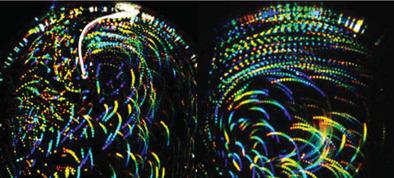Our official English website, www.x-mol.net, welcomes your
feedback! (Note: you will need to create a separate account there.)
A Pulsatile Flow System to Engineer Aneurysm and Atherosclerosis Mimetic Extracellular Matrix.
Advanced Science ( IF 14.3 ) Pub Date : 2020-04-30 , DOI: 10.1002/advs.202000173 Vahid Hosseini 1, 2 , Anna Mallone 3 , Nima Mirkhani 4 , Jerome Noir 5 , Mehdi Salek 6 , Francesco Silvio Pasqualini 3, 7 , Simone Schuerle 4 , Ali Khademhosseini 8 , Simon P Hoerstrup 3 , Viola Vogel 1
Advanced Science ( IF 14.3 ) Pub Date : 2020-04-30 , DOI: 10.1002/advs.202000173 Vahid Hosseini 1, 2 , Anna Mallone 3 , Nima Mirkhani 4 , Jerome Noir 5 , Mehdi Salek 6 , Francesco Silvio Pasqualini 3, 7 , Simone Schuerle 4 , Ali Khademhosseini 8 , Simon P Hoerstrup 3 , Viola Vogel 1
Affiliation

|
Alterations of blood flow patterns strongly correlate with arterial wall diseases such as atherosclerosis and aneurysm. Here, a simple, pumpless, close‐loop, easy‐to‐replicate, and miniaturized flow device is introduced to concurrently expose 3D engineered vascular smooth muscle tissues to high‐velocity pulsatile flow versus low‐velocity disturbed flow conditions. Two flow regimes are distinguished, one that promotes elastin and impairs collagen I assembly, while the other impairs elastin and promotes collagen assembly. This latter extracellular matrix (ECM) composition shares characteristics with aneurysmal or atherosclerotic tissue phenotypes, thus recapitulating crucial hallmarks of flow‐induced tissue morphogenesis in vessel walls. It is shown that the mRNA levels of ECM of collagens and elastin are not affected by the differential flow conditions. Instead, the differential gene expression of matrix metalloproteinase (MMP) and their inhibitors (TIMPs) is flow‐dependent, and thus drives the alterations in ECM composition. In further support, treatment with doxycycline, an MMP inhibitor and a clinically used drug to treat vascular diseases, halts the effect of low‐velocity flow on the ECM remodeling. This illustrates how the platform can be exploited for drug efficacy studies by providing crucial mechanistic insights into how different therapeutic interventions may affect tissue growth and ECM assembly.
中文翻译:

用于设计动脉瘤和动脉粥样硬化模拟细胞外基质的脉动流系统。
血流模式的改变与动脉粥样硬化和动脉瘤等动脉壁疾病密切相关。在这里,引入了一种简单、无泵、闭环、易于复制和小型化的流动装置,以同时将 3D 工程血管平滑肌组织暴露于高速脉动流和低速扰动流条件下。有两种流动方式,一种促进弹性蛋白并损害 I 型胶原蛋白的组装,而另一种则损害弹性蛋白并促进胶原蛋白的组装。后者的细胞外基质(ECM)成分与动脉瘤或动脉粥样硬化组织表型具有共同的特征,因此概括了血管壁中血流诱导的组织形态发生的关键特征。结果表明,胶原蛋白和弹性蛋白的 ECM mRNA 水平不受不同流动条件的影响。相反,基质金属蛋白酶 (MMP) 及其抑制剂 (TIMP) 的差异基因表达是流量依赖性的,从而驱动 ECM 成分的变化。在进一步的支持中,使用强力霉素(一种 MMP 抑制剂和一种临床使用的治疗血管疾病的药物)进行治疗,可以阻止低速血流对 ECM 重塑的影响。这说明了如何利用该平台进行药物功效研究,通过提供不同治疗干预如何影响组织生长和 ECM 组装的关键机制见解。
更新日期:2020-06-24
中文翻译:

用于设计动脉瘤和动脉粥样硬化模拟细胞外基质的脉动流系统。
血流模式的改变与动脉粥样硬化和动脉瘤等动脉壁疾病密切相关。在这里,引入了一种简单、无泵、闭环、易于复制和小型化的流动装置,以同时将 3D 工程血管平滑肌组织暴露于高速脉动流和低速扰动流条件下。有两种流动方式,一种促进弹性蛋白并损害 I 型胶原蛋白的组装,而另一种则损害弹性蛋白并促进胶原蛋白的组装。后者的细胞外基质(ECM)成分与动脉瘤或动脉粥样硬化组织表型具有共同的特征,因此概括了血管壁中血流诱导的组织形态发生的关键特征。结果表明,胶原蛋白和弹性蛋白的 ECM mRNA 水平不受不同流动条件的影响。相反,基质金属蛋白酶 (MMP) 及其抑制剂 (TIMP) 的差异基因表达是流量依赖性的,从而驱动 ECM 成分的变化。在进一步的支持中,使用强力霉素(一种 MMP 抑制剂和一种临床使用的治疗血管疾病的药物)进行治疗,可以阻止低速血流对 ECM 重塑的影响。这说明了如何利用该平台进行药物功效研究,通过提供不同治疗干预如何影响组织生长和 ECM 组装的关键机制见解。











































 京公网安备 11010802027423号
京公网安备 11010802027423号